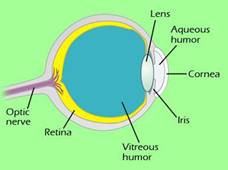


Main components of the human eye include:
The retina - Light-sensitive layer at the back of the eyeball onto which incoming light is focused. It contains cells that respond to colours, different shades of grey, and movement. These cells trigger nerve impulses that are carried by the optic nerve to the brain, where a visual image is formed.
The cornea - The dome-shaped, transparent layer that forms the front of the eyeball. It bends light entering the eye into the lens, and hence helps to focus images onto the retina. It contains no blood vessels and is extremely sensitive to pain.
The lens - Transparent elastic structure situated behind the pupil of the eye that focuses incoming light onto the retina. Muscles in the eye can adjust the shape of the lens and make it more flattened to focus on distant objects, or make it more rounded to focus on near objects.
The vitreous humour - The transparent jelly-like substance that fills the eyeball between the lens and the retina.
Source: GreenFacts

Source: Matticus 78![]()
Deutsch: Auge
Español: Ojo
Français: Oeil